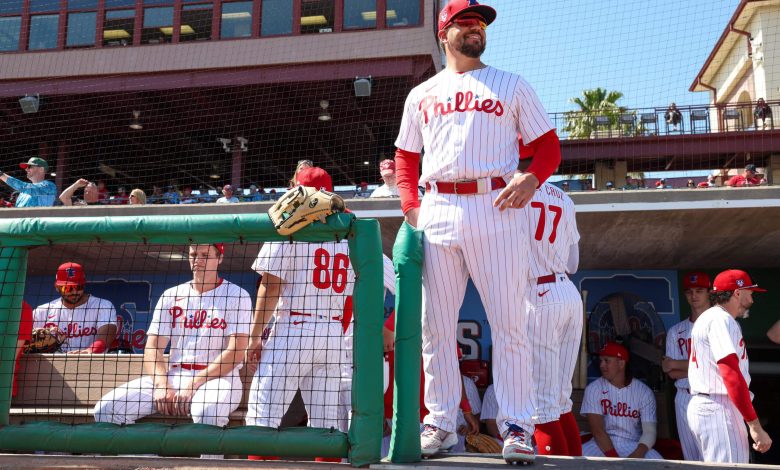Explainer: What we know — and don’t — about MLB’s ongoing issues with Nike uniforms

In the sweltering summer of 1994, back when Russell Athletics was Major League Baseball’s official uniform supplier, the New York Yankees suddenly switched jersey fabrics, from polyester to a more breathable cotton, to beat the heat. Yankees players raved about the cotton uniforms in a front-page story.
Luis Polonia: “Cotton is king.”
Wade Boggs: “What a fabric! Finally we can breathe.”
Paul O’Neill: “I never dreamed anything could be so soft and fluffy.”
Thirty years later, Nike, MLB’s current uniform supplier, introduced a new jersey — 90 percent recycled polyester — that got equally glowing reviews.
Adley Rutschman: “Much more breathable.”
Nolan Arenado: “It’s almost like wearing my favorite shirt out on the field.”
Ronald Acuña Jr.: “Feeling free in the jersey is the best feeling in the world.”
The difference?
The Nike jersey is real. The cotton one is from an episode of “Seinfeld.”
It’s easy to imagine this suggestion from Yankees assistant to the traveling secretary George Costanza to manager Buck Showalter now on a Nike pitch deck: “Imagine playing games and your team is five degrees cooler than the other team. Don’t you think that would be an advantage? They’re cooler. They’re more comfortable. They’re happier — they’re going to play better.”
It’s been 10 days since we started reporting about the many missteps in the Nike Vapor Premier rollout, and the groans have only grown louder. Here’s what we know — and don’t — about MLB’s ongoing jersey issues.
What are players upset about?
Depends on the day. MLBPA executive director Tony Clark said new issues keep arising as he moves from camp to camp during spring training. The first complaints were about the design and feel of the jerseys. Concerns have since coalesced around the pants. Players have complained that instead of receiving fully tailored pants as in the past they now are measured, put into one of four body-type buckets and given pants that should fit someone shaped like them. Many are not satisfied.
Then came the pants shortage and the, uh, see-through thing.
The see-through what?
The pants. They’re sorta see-through.
How sorta?
Enough to see tags and logos underneath the white pants. Enough to make the long tails of the tucked-in jersey top look like a diaper. Enough that spouses are making jokes about it. No one asked for this kind of transparency in baseball.
Scott Barlow welcome to Cleveland pic.twitter.com/fmGVQBJESR
— Andre Knott (@DreKnott) February 22, 2024
The question is: Are these pants more see-through than pants from past years?
A source familiar with the process said the pant fabric has not changed; another said the material and thickness are the same. That sentiment has been shared in several tweets and stories. However, a Nike spokesperson did not respond to The Athletic’s requests for clarity on whether this exact pant design — belt loops aside — was used last year, and, if so, what year this pant was first introduced.
Without a clear answer, skepticism seems warranted.
Uni Watch’s Paul Lukas, who has written extensively about the new Nike jerseys on his site and Substack, said he saw a “somewhat similar phenomenon” in photos from previous years’ photo days. “To me,” he said, “it was not as severe.”
Wouldn’t we have noticed if the pants had been this translucent in the past?
That seems to be the general consensus on Baseball Twitter. On one hand, everything about these uniforms is being more closely scrutinized than any jersey in recent memory. On the other, this see-through effect is not just occurring in the studio lighting of photo day. We’re seeing players’ undergarments in poorly-lit lobbies and on outdoor ballfields as well.
I didn’t notice it during my team’s game this weekend, though.
You might not!
One reason for that: your team might be wearing last year’s pants.
That’s right, teams are short on pants. Typically, according to a handful of players surveyed, they’ll have about five pairs of tailored game pants in their locker a couple of weeks before Opening Day. Currently, some teams have none, and some one. It’s not clear which company is at fault for the shortage — Nike, which engineered and designed the uniforms; or Fanatics, which manufactures them.
in case anyone was wondering, it looks like the Padres are wearing the OLD (not transparent) white pants, while Dodgers are wearing the NEW grey pants.
(you can tell by the belt loops.) https://t.co/6TKuGicD43 pic.twitter.com/z12pBWiUlY
— ric sanchez (@ricsanchez) February 22, 2024
What have MLB, Nike and Fanatics said about all this?
Very little.
Nike and MLB issued statements Friday, though neither has answered specific questions regarding the new jerseys.
A Fanatics spokesperson has declined multiple requests for comment.
Whose fault is this?
In the simplest explanation — following the responsibilities as laid out by MLB, Fanatics and Nike before Nike became MLB’s official uniform supplier in December 2019 — blame would primarily fall on Nike. That’s how Lukas sees it. That’s also how Clark, the union chief, sees it. Nike had four years to land its transition from the Majestic Athletics template to a Nike one. It so far has flopped.
Fanatics, however, has taken most of the heat from fans for the new jerseys. That’s because of Fanatics’ history of selling sub-par (or worse) products to consumers as it dominates the licensed sports apparel market. It is an earned reputation. In the case of these Nike jerseys, Fanatics produces the final product, so any imperfections or inconsistencies in the stitching, lettering and patchwork could be attributed to them. But the material and design changes are Nike choices.
What are some of the design choices?
The white uniforms are a slightly off-white shade. The pants have different belt loops. Certain embroidered elements are now printed. The fabric looks, as Lukas writes, like a paper towel. On the front of the jersey top, a narrower placket has led to some awkward split-letter chest scripts. The back of the jersey has changed dramatically. First, Nike lowered the MLB logo. The lettering is significantly smaller. And the uniform number, also smaller in most cases, was perforated for optimal airflow.
“Something about the smaller lettering just doesn’t look major league,” Lukas said, “and there’s been no explanation for why. That’s what I’ve found so surprising and confounding.”
He brought up the example of the Indianapolis Colts’ shoulder stripes.
“The shoulder stripes don’t extend as far as they used to, like when we were growing up,” Lukas said, “because the stripe is interrupted by a seam that didn’t exist when we were growing up, because they’ve changed the way they sew and tailor the jersey. OK, I don’t really love that, but at least there’s an explanation I can understand. Form follows function. For these changes, they haven’t given any explanation.”
Is there time to change anything before Opening Day?
It’s unlikely anything substantial will change with the design. It appears the priority will be to fix the pant fit issues — as soon as there are enough pants.
What would Costanza do?
Stan for cotton.
Cotton breathes.
Polyester, you know, it’s not a natural fiber.
This weekend we tracked down Jason Alexander — the actor who played Costanza, not the reliever. Alexander declined an interview. He’s not really a sports fan, his publicist said, so he hasn’t been following the Nike snafu and therefore doesn’t have strong opinions about the new jerseys.
Well, that makes one of us.
(Photo of Kyle Schwarber: Nathan Ray Seebeck / USA Today)
#Explainer #dont #MLBs #ongoing #issues #Nike #uniforms





